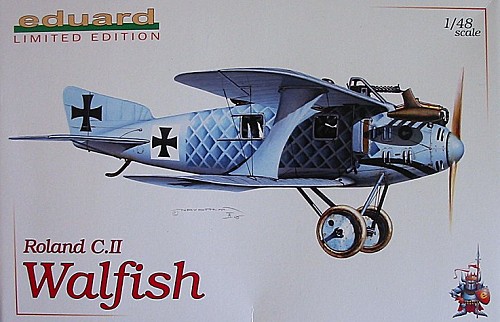
| KIT: | Eduard 1/48 Roland C.II 'Walfisch' |
| KIT #: | ? |
| PRICE: | $ |
| DECALS: | ? options |
| REVIEWER: | Tom Cleaver |
| NOTES: |

| HISTORY |
The Roland C.II first appeared over the Western Front in April 1916, having been designed in 1915 and was one of the best-looking airplanes - single or two-seat - to appear during the Great War.
The C.II was a quantum leap in design thinking over its contemporaries in any air force. By extending the fuselage to be coincident with the top wing, the entire cabane structure was done away with, while the interplane struts were replaced with a single streamlined "I" strut. While doing away with a drag-producing structure, the design also created a much stronger mounting for the upper wing. The fuselage ended up "whale-shaped," which is how it received its nickname "Walfisch."
The C.II had a performance on par with the Nieuport 17 and Sopwith Pup fighters, and far ahead of the deHavilland D.H.2, and easily outperformed every other two-seater at the front throughout 1916.
Despite its streamlined construction, the airplane had several Achilles’ heels. The attachment of the wing did away with drag-producing struts at the expense of a narrow wing gap which caused the airplane to stall easily; this was coupled with a violent sink rate which caught new pilots unawares. The lack of strength of the very thin airfoil section caused wing failure during dogfights. Additionally, the pilot had a difficult downward view in landing, which exacerbated the flying characteristics.
Despite this, the Walfisch was an excellent escort for slower two-seaters, and was successful in long-range reconnaissance and battlefield bombing. Originally armed only with a single LMG '08 machine gun for the observer, later versions provided a similar weapon for the pilot, though this exacerbated forward vision over the gun.
The Walfisch was obsolete by the Spring of 1917, and those that were left were used as trainers for the rest of the war.
| THE KIT |
 Eduard first released the Roland Walfisch in 2000, in both the all-plastic
“basic” version and the “profi-pack” version with photoetch details.
Eduard first released the Roland Walfisch in 2000, in both the all-plastic
“basic” version and the “profi-pack” version with photoetch details.
The kit has excellent production design and is very easy to assemble, for
thos e
who find themselves challenged in constructing biplanes. The rigging is
very simple, which can increase its interest to those who feel they are
“rigging-challenged.”
e
who find themselves challenged in constructing biplanes. The rigging is
very simple, which can increase its interest to those who feel they are
“rigging-challenged.”
 I particularly like the fact that the markings included are for the famous
“fish” flown by Leutnant Seibert and Hauptmann Pfleger of
Feldflieger Abteilung 5b during the Fall of 1916, and an
otherwise-anonymous C.II with black-and-white checkerboard markings on the
lower wings and tail. I have a profi-pack C.II kit that had stalled out
over a desire to have other markings, so now I can do both these markings.
I particularly like the fact that the markings included are for the famous
“fish” flown by Leutnant Seibert and Hauptmann Pfleger of
Feldflieger Abteilung 5b during the Fall of 1916, and an
otherwise-anonymous C.II with black-and-white checkerboard markings on the
lower wings and tail. I have a profi-pack C.II kit that had stalled out
over a desire to have other markings, so now I can do both these markings.
| CONCLUSIONS |
The Roland Walfisch is one of the better-looking World War I airplanes, with a simple design that will allow a modeler who has never done a World War I model to create a good-looking addition to their collection. Highly recommended.
December 2005
Thanks to Eduard for the review sample.
If you would like your product reviewed fairly and quickly by a site that has over 300,000 visitors a month, please contact me or see other details in the Note to Contributors.